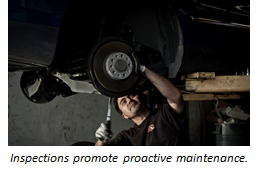Anyone tasked with maintenance responsibility at a company should be championing equipment inspections as hard as they can. That’s because equipment inspections, when done regularly and properly, can reduce maintenance costs and the burden on the maintenance department.
Identification of Equipment Problems Before They Escalate
In a company that’s efficiently maintaining its equipment, most of the maintenance work orders should be for preventative maintenance—not for much-more-costly repair. And most of the repair work should be for problems that are caught early, before they become more costly to fix.
 But without mandated regular inspections that are real checks—and not simply pencil-whipped documentation—many problems that could be prevented or repaired for relatively little cost go undiscovered and/or unreported until the problem’s seriousness and cost escalate.
But without mandated regular inspections that are real checks—and not simply pencil-whipped documentation—many problems that could be prevented or repaired for relatively little cost go undiscovered and/or unreported until the problem’s seriousness and cost escalate.
Much more often than you might think, failure to properly inspect equipment results in equipment being used in a way that makes a problem significantly worse, or even destroys the equipment. Regular inspections—documented with equipment inspection checklists such as The Checker to ensure they’re done properly— keep such mishaps from happening.
More-Strategic Maintenance Scheduling
With the information gained from regular, documented, and thorough inspections, preventative maintenance schedules can be developed with more precision and less cost. Regular inspections tell you when equipment breaks down, allowing you to schedule maintenance when it’s most cost-effective, before equipment failures occur.
Using equipment checklists integrated into inspection management software—a solution offered by The Checker—inspection data can be aggregated and reported to provide valuable guidance about when equipment will need attention.
Positive Attitude Change
Operators can be rough on the equipment they use, but regularly required equipment inspections encourage them to take better care of it. Insisting on documentation of a properly conducted pre-use inspection means that operators will “own” problems once they begin using the equipment. If they fail to conduct a proper inspection and don’t report a problem, and the problem then becomes apparent during operation, the only assumption the company can make is that the problem occurred while that operator was using the equipment on that day.
Operators who don’t want to take that heat will be sure to complete the checklists—and to take care not to damage the equipment while using it!
But fear of being accused of breaking equipment isn’t the only motivation that’s accomplished with pre-use inspections. They also inspire operators to genuinely care about the condition of their equipment, because of the simple truth that the more attention you pay to something, the more it usually matters to you. With better care, comes less wear and tear because of more-gentle handling. You might even start to see “self-policing” behavior.
Conclusion
A company requirement for documentation of regularly conducted equipment inspections done the right way is highly beneficial in controlling maintenance cost because inspections catch equipment problems early when they’re less expensive to fix, improve maintenance scheduling, and encourage operators to take better care of equipment.










